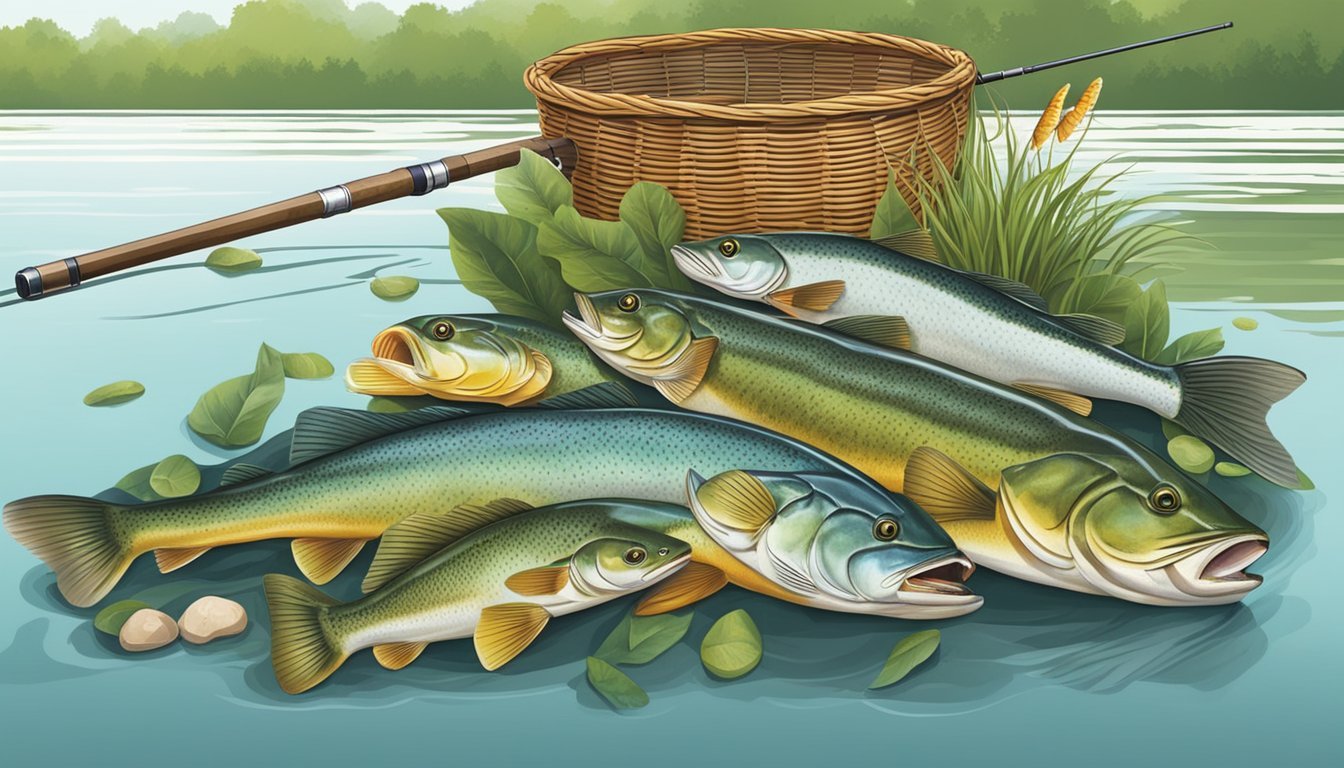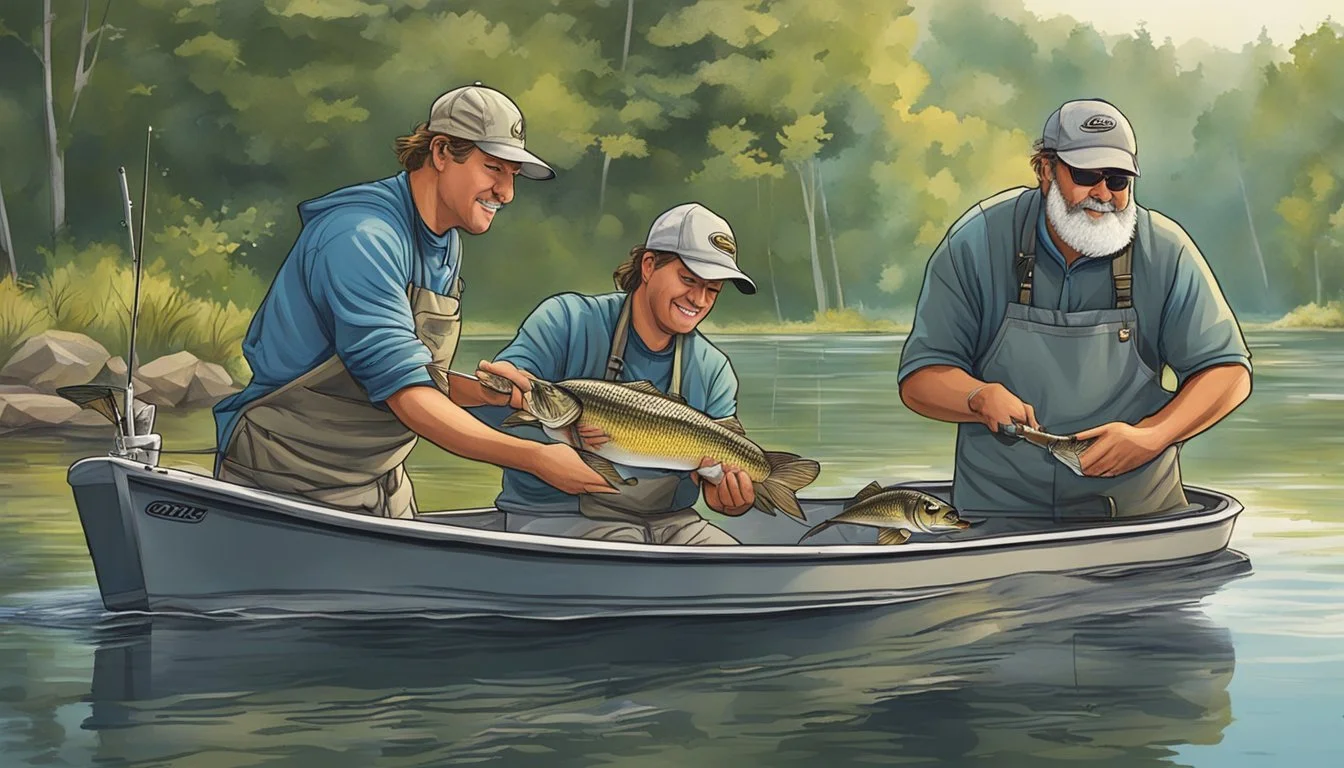Best Fish to Catch and Eat in Ohio
Your Ultimate Guide
Ohio offers a rich tapestry of freshwater fishing opportunities, with an array of fish (What wine goes well with fish?) species that are both enjoyable to catch and delicious to eat. Among the sought-after catches in central Ohio, crappie and bluegill stand out as favorites, offering not only a satisfying challenge for anglers but also a delightful meal. Public spots such as Three Creeks, accessible off of Williams Road, are ideal destinations for those looking to introduce the younger generation to the sport, providing a safe and welcoming environment for new enthusiasts.
The state also presents a thoughtful guide with the annual Ohio Sport Fish Consumption Advisory, which provides updated information on the healthiest fish to catch and consume. This advisory is part of Ohio's commitment to ensuring that the pastime of fishing is both sustainable and safe for everyone. Alongside these recommendations, species lower in mercury, such as catfish and cod, are available for those conscious of environmental and health considerations.
Ohio's geographical diversity, from the Ohio River to Lake Erie, supports different habitats hosting a variety of fish species. Seasonal approaches to fishing in these waters allow for an engaging experience throughout the year. In the northern reservoirs and Lake Erie, one can target fish like the stocked rainbow trout, which although not native to Ohio, add to the breadth of fishing experiences available to anglers in the state. The combination of these factors makes Ohio a noteworthy destination for those passionate about fishing.
Choosing the Right Fish to Catch
When fishing in Ohio waters, it's important to select species that are not only enjoyable to catch but also safe and delicious to eat. Below are key considerations and guidelines for making the best choice.
Assessing Ohio's Popular Fish Species
Perch, Bluegill, and Crappie offer delightful fishing experiences and are popular for their tastiness, especially when caught in clean waters. Saugeye and Yellow Perch are sought after in Ohio for their delectable white meat. For anglers seeking a challenge, sportier fish like Largemouth Bass, Smallmouth Bass, and Walleye can provide a rewarding catch. Trout enthusiasts often aim for Steelhead Trout or Rainbow Trout during their seasonal runs.
Season Ideal Fish Species Spring Crappie, Saugeye, Rainbow Trout Summer Bluegill, Catfish, Bass Fall Perch, Walleye, Muskellunge
Understanding the Ohio Department of Natural Resources Guidelines
The Ohio Department of Natural Resources (ODNR) provides crucial guidelines for a safe and sustainable fishing experience. The Ohio Sport Fish Consumption Advisory suggests which fish species are better choices health-wise by indicating serving sizes and highlighting fish with potential contaminants such as lead.
Evaluating Fishing Opportunities Throughout the Seasons
Fishing opportunities vary as the seasons change. May through early morning in June are peak times for catching Bluegill. In September, the cooler waters bring abundant Walleye closer to shore, making it an excellent time to catch. As for Catfish, summer nights provide prime conditions. The ODNR provides a calendar suggesting the best times for fishing various species, considering factors such as spawning times and seasonal migrations.
Ideal Fishing Locations in Ohio
Ohio is a haven for anglers with its plethora of lakes, rivers, and ample shoreline offering a diverse range of fishing experiences.
Navigating Ohio's Lakes and Reservoirs
When it comes to freshwater fishing in Ohio, lakes and reservoirs are prime spots for angling. Lake Erie, with its extensive surface area, stands out as a premium fishing location for an assortment of species. Mosquito Lake is another notable destination, renowned for its abundance of walleye and bass. Indian Lake and Alum Creek Lake both provide excellent opportunities for catching various species of fish. Seneca Lake and Piedmont Lake are also favored for their stocks of fish, scenic environments, and accessible facilities. Additionally, Lake Milton and Mosquito Creek Lake offer generous populations of fish, making them ideal for both boat-based and shore fishing.
Lake Erie: Walleye, Perch, Bass
Mosquito Lake: Walleye, Bass
Indian Lake: Crappie, Bluegill, Bass
Alum Creek Lake: Bass, Muskie, Crappie
Seneca Lake: Bass, Saugeye
Piedmont Lake: Muskie, Bass
Lake Milton: Walleye, Bass
Mosquito Creek Lake: Bass, Northern Pike
Exploring Rivers and Creeks
Ohio's rivers and creeks are vibrant ecosystems where anglers can find both sport and sustenance. The Ohio River is a vast waterway with an array of fish species, while the Tuscarawas, Maumee, and Scioto Rivers all provide significant fishing prospects. The Great Miami and Mahoning Rivers are known for their catfish and smallmouth bass populations. For tranquil settings and potential trophy catches, the Little Miami and Huron Rivers are popular choices. Additionally, Muskingum River offers a serene fishing experience along with diverse fish species.
Ohio River: Catfish, Bass, Saugeye
Tuscarawas River: Walleye, Smallmouth Bass
Maumee River: Walleye, White Bass
Scioto River: Smallmouth Bass, Catfish
Great Miami River: Catfish, Smallmouth Bass
Mahoning River: Walleye, Smallmouth Bass
Little Miami River: Bass, Bluegill
Huron River: Northern Pike, Walleye
Muskingum River: Muskie, Walleye
Finding the Best Spots for Shore Fishing
Shore fishing in Ohio can be as rewarding as boating into deeper waters. Lake Erie's coast is notably accessible for shore anglers looking to catch a variety of fish. Findlay Reservoir and smaller bodies like Mosquito Creek are conducive to shore fishing, with ample space to cast and a good fish presence. Public access points along these waters make them convenient and highly recommended for those who enjoy fishing from the bank.
Lake Erie: Accessible shore fishing for Walleye, Perch, Bass
Findlay Reservoir: Panfish, Trout
Mosquito Creek: Catfish, Carp
Fishing Techniques and Tackle
In Ohio, the effectiveness of fishing techniques and tackle varies with the species targeted. Anglers need to be equipped with the right bait and lures, and master various fishing methods to maximize their fishing experience.
Selecting the Right Bait and Lures
Bait and lures are crucial in attracting and catching fish. For walleye fishing, a popular sport in Ohio, jigs and crankbaits are highly effective. These mimic small fish, which are a natural prey for walleye. Seasoned anglers often use nightcrawlers or shrimp, (What wine goes well with shrimp?) which can be particularly enticing when river fishing for species like catfish. On the other hand, spoons and spinners prove invaluable for their flashy appearance and movement, attracting species such as bass.
Fish Species Recommended Lures Recommended Baits Walleye Jigs, Crankbaits Nightcrawlers, Minnows Bass Spinners, Crankbaits Plastic Worms Catfish Nightcrawlers, Shrimp Nightcrawlers, Chicken Liver
Mastering Various Fishing Methods
For a well-rounded fishing experience, anglers should be familiar with different fishing methods. Fly fishing is an artful technique that requires skill and patience, often used for catching trout and occasionally for bass in Ohio. Tackle for fly fishing is specialized, with lightweight rods and specifically designed flies to imitate aquatic insects. For those targeting walleye or bass, casting or trolling with crankbaits can yield good results. Each method has its own rhythm and motion, and the choice depends on the target species, weather, and water conditions.
Fly Fishing: Utilize flies and a fly rod to mimic local insects. Effective for trout and bass.
Casting: Cast lures such as jigs and spinners along shorelines or over structures.
Trolling: Drag lures such as spoons or crankbaits behind a moving boat to attract fish like walleye.
Fishing Regulations and Conservation
Fishing in Ohio offers a diverse range of species for anglers, but it is crucial to adhere to local laws to ensure resource sustainability. Here are the key considerations for fishing regulations and the importance of conservation practices in the Buckeye State.
Understanding Local Fishing Laws
Ohio enforces specific fishing regulations to maintain healthy fish populations and aquatic ecosystems. A notable rule is the sunfish daily limit which stands at 15, and only five of these can be 8 inches or larger. Largemouth bass are subject to an 18-inch minimum length requirement with a daily limit of five fish. Additionally, channel catfish have a two-fish daily limit. Anglers should reference the Ohio Department of Natural Resources for area-specific regulations, including any "Do Not Eat" advisories due to contaminants, such as PAHs found in specific bodies of water like the Little Scioto River.
Promoting Sustainable Fishing Practices
Conservation is a shared responsibility; it ensures that future generations can enjoy Ohio fishing. Sustainable fishing practices include abiding by set daily limits and size requirements. It is also advisable to follow catch-and-release guidelines for fish from certain areas as recommended by the Ohio Sport Fish Consumption Advisory. By limiting harvests to healthier populations and avoiding consumption of contaminated species, anglers contribute to conservation efforts and help protect Ohio’s aquatic wildlife.
Planning Your Fishing Trip
When venturing out on an Ohio fishing excursion, one should take into account the optimal periods for fishing as well as selecting prime locations. A well-prepared angler is mindful of safety and the likelihood of a successful catch.
Best Times to Fish in Ohio
The Ohio Department of Natural Resources has found that the best times to fish are typically early morning and late evening, as fish are more active and feeding during these cooler parts of the day. For many species, summer and fall present high catch rates, making them ideal seasons for a fishing trip.
Summer: Long daylight hours and warm water temperatures increase fish activity.
Fall: Cooling water temps can lead to robust feeding patterns as fish prepare for winter.
Selecting Your Fishing Location
Ohio boasts a variety of fishing environments, from the flowing waters of rivers to the stillness of lakes, ponds, and reservoirs. One can choose from several celebrated fishing spots:
Lakes: Lake Erie, especially around Lorain and Ashtabula County, offers a dynamic fishing experience.
Rivers and Streams: Mad River welcomes anglers seeking trout.
Ponds and Reservoirs: Portage Lakes' chain and Buckeye Lake are prime spots for largemouth bass.
Hotspots: Port Clinton is renowned as the "Walleye Capital of the World."
Each environment attracts different species and offers unique challenges and opportunities.
Preparing for Safety and Success
Packing the right gear and being prepared for varying conditions are crucial. The Ohio Department of Natural Resources advises on safety regulations and environmental stewardship. They suggest the following:
Gear Checklist:
Life jackets
First aid kit
Sun protection (hat, sunscreen)
Appropriate clothing for weather changes
Fishing Kit:
Rods and reels suitable for target species
A variety of bait and lures
Tackle box with hooks, weights, and line
Adherence to safety guidelines ensures a rewarding and responsible fishing experience across Ohio's diverse aquatic landscapes.
Regional Highlights for Anglers
Ohio offers an abundance of fishing opportunities for anglers looking to reel in both sport and edible fish. The state is known for its diverse fishing ecosystems ranging from the vast waters of Lake Erie to the quiet inlets of Salt Fork Lake.
Notable Fishing Areas in Ohio
Lake Erie: This Great Lake is renowned for its walleye and perch fishing. With Lorain County providing ample access points, anglers can expect vast fishing grounds and potentially lucrative catches.
Salt Fork Lake: Located in Guernsey County, this lake is celebrated for its largemouth bass and is a common destination for tournaments and recreational fishing alike.
Other Popular Fishing Spots:
Leesville Lake: Ideal for muskellunge and saugeye fishing.
Mad River: Known for its thriving populations of brown and rainbow trout, offering premier fly-fishing experiences.
Local Fishing Festivals and Events
Ohio celebrates its fishing culture with a variety of festivals and events throughout the year, which not only highlight the sport but also focus on conservation and education.
Walleye Festival: An annual event in Port Clinton, featuring tournaments and family entertainment.
Bass Fishing Tournaments: Held across various Ohio lakes, including Salt Fork Lake, drawing competitive anglers from all over.
Fishing Culture in the Buckeye State
Fishing in Ohio, often referred to as the Buckeye State, is more than a pastime—it's a significant part of local lifestyle and economy. It brings together anglers of all ages, fostering a community that values natural resources and outdoor recreation.
Community Support: Fishing clubs and organizations play a big role in protecting Ohio's waterways and fish populations.
Educational Initiatives: Workshops and youth programs aim to educate new anglers on sustainable fishing practices.
Eating Your Catch
In Ohio, anglers can enjoy a variety of fish suitable to catch and eat when following safe preparation and consumption practices outlined by health advisories.
Cleaning and Preparing Fish
Proper cleaning and preparation are vital steps to ensure the quality and safety of Ohio fish. For all species, it begins with swift evisceration and removal of gills, followed by thorough cleaning under cold water. Skinning and filleting techniques vary by species but are crucial in reducing exposure to contaminants. Anglers should familiarize themselves with the specific cleaning methods recommended for the fish they harvest.
Health Benefits and Risks of Ohio Fish
Eating locally-caught fish from Ohio can offer numerous health benefits due to the high-quality protein, omega-3 fatty acids, and other essential nutrients found in species such as salmon, shrimp, pollock, tilapia, catfish, and cod. These commonly consumed fish are associated with lower mercury levels and are listed as safer choices in the Ohio Sport Fish Consumption Advisory.
However, caution must be exercised as some species have advisories due to contaminants like mercury and lead. Fish such as swordfish, orange roughy, bigeye tuna, marlin, and king mackerel are noted for higher mercury content, and consumption should be limited, especially for pregnant women and children. Anglers are encouraged to refer to the latest Ohio Sport Fish Consumption Advisory for species-specific serving sizes and frequency to minimize health risks.
Conclusion
Ohio offers a diverse and rewarding fishing experience, with a variety of species that are both enjoyable to catch and safe to consume. Fishing enthusiasts can target largemouth bass, a powerful and popular catch found statewide, including in Lake Erie and Alum Creek Reservoir.
For those concerned about health, Ohio Department of Health provides clear guidance on fish consumption. The best choices with lower mercury levels, commonly consumed and available in Ohio, include:
Shrimp
Salmon
Canned light tuna
Tilapia
Catfish
Cod
Anglers should note that some species like swordfish, bigeye tuna, and king mackerel have higher mercury content and should be consumed less frequently. According to the 2023 Ohio Sport Fish Consumption Advisory, most sport fish in Ohio are safe to eat at a rate of one meal per week.
Fishermen are encouraged to check the latest advisories, as they provide detailed recommendations to ensure both the pleasure of fishing and the safety of consumption. By adhering to these guidelines, both amateur and seasoned anglers can enjoy Ohio's waters sustainably and healthfully.






